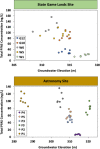Spatiotemporal patterns of PFAS in water and crop tissue at a beneficial wastewater reuse site in central Pennsylvania
- PMID: 36070520
- PMCID: PMC9828414
- DOI: 10.1002/jeq2.20408
Spatiotemporal patterns of PFAS in water and crop tissue at a beneficial wastewater reuse site in central Pennsylvania
Abstract
Per- and polyfluoroalkyl substances (PFAS) are a collective name for thousands of synthetic compounds produced to enhance consumer and industrial products since the 1940s. They do not easily degrade, and some are known to pose serious ecological and human health concerns at trace concentrations (ng L-1 levels). Per- and polyfluoroalkyl substances persist in treated wastewater and are inadvertently introduced into the environment when treated wastewater is reused as an irrigation source. The Pennsylvania State University (PSU) has been spray-irrigating its wastewater at a 2.45 km2 mixed-use agricultural and forested site known as the "Living Filter" since the 1960s. To understand the spatiotemporal patterns of 20 PFAS at the Living Filter, water samples were collected bimonthly from fall 2019 through winter 2021 from the PSU's wastewater effluent and from each of the site's 13 monitoring wells. Crop tissue was collected at the time of harvest to assess PFAS presence in corn silage and tall fescue grown at the study site. Total measured PFAS concentrations in the monitoring wells ranged from nondectable to 155 ng L-1 , with concentrations increasing with the direction of groundwater flow. Concentrations within each well exhibited little temporal variability across sampling events, with mixed relationships between PFAS and groundwater elevation observed between wells. Further, >84% of the PFAS present in livestock feed crops were short-chain compounds, with PFAS consumed annually by livestock fed crops harvested from the site estimated to be 2.46-7.67 mg animal-1 yr-1 . This research provides insight into the potential impacts of long-term beneficial reuse of treated wastewater on groundwater and crop tissue quality.
© 2022 The Authors. Journal of Environmental Quality published by Wiley Periodicals LLC on behalf of American Society of Agronomy, Crop Science Society of America, and Soil Science Society of America.
Conflict of interest statement
Authors H.E. Preisendanz and T.L. Veith reside in the same household. The authors declare no other conflict of interest.
Figures




References
-
- Agency for Toxic Substances and Disease Registry (ATSDR) . (2018). Toxicological profile for perfluoroalkyls. U.S. Department of Health and Human Services. https://www.atsdr.cdc.gov/toxprofiles/tp200.pdf - PubMed
-
- Blaine, A. C. , Rich, C. D. , Hundal, L. S. , Lau, C. , Mills, M. A. , Harris, K. M. , & Higgins, C. P. (2013). Uptake of perfluoroalkyl acids into edible crops via land applied biosolids: Field and greenhouse studies. Environmental Science & Technology, 47, 14062–14069. 10.1021/es403094q - DOI - PubMed
-
- Blaine, A. C. , Rich, C. D. , Sedlacko, E. M. , Hyland, K. C. , Stushnoff, C. , Dickenson, E. R. V. , & Higgins, C. P. (2014). Perfluoroalkyl acid uptake in lettuce (Lactuca sativa) and strawberry (Fragaria ananassa) irrigated with reclaimed water. Environmental Science & Technology, 48, 14361–14368. 10.1021/es504150h - DOI - PubMed
-
- Buck, R. C. , Franklin, J. , Berger, U. , Conder, J. M. , de Voogt, P. , Mabury, S. A. , Cousins, I. T. , Kannan, K. , Jensen, A. A. , & van Leeuwen, S. P. (2011). Perfluoroalkyl and polyfluoroalkyl substances in the environment: Terminology, classification, and origins. Integrated Environmental Assessment and Management, 7, 513–541. 10.1002/ieam.258 - DOI - PMC - PubMed
MeSH terms
Substances
Grants and funding
LinkOut - more resources
Full Text Sources

